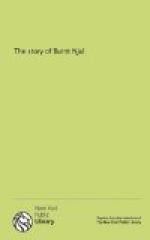In addition, to his Scandinavian work, Sir George Dasent wrote several novels, of which The Annals of an Eventful Life was at once the most popular and the best. He died greatly respected in 1896.
E. V. LUCAS.
SIR GEORGE DASENT’S PREFACE
(ABRIDGED.)
What is a Saga? A Saga is a story, or telling in prose, sometimes mixed with verse. There are many kinds of Sagas, of all degrees of truth. There are the mythical Sagas, in which the wondrous deeds of heroes of old time, half gods and half men, as Sigurd and Ragnar, are told as they were handed down from father to son in the traditions of the Northern race. Then there are Sagas recounting the history of the kings of Norway and other countries, of the great line of Orkney Jarls, and of the chiefs who ruled in Faroe. These are all more or less trustworthy, and, in general, far worthier of belief than much that passes for the early history of other races. Again, there are Sagas relating to Iceland, narrating the lives, and feuds, and ends of mighty chiefs, the heads of the great families which dwelt in this or that district of the island. These were told by men who lived on the very spot, and told with a minuteness and exactness, as to time and place, that will bear the strictest examination. Such a Saga is that of Njal, which we now lay before our readers in an English garb. Of all the Sagas relating to Iceland, this tragic story bears away the palm for truthfulness and beauty. To use the words of one well qualified to judge, it is, as compared with all similar compositions, as gold to brass.[1] Like all the Sagas which relate to the same period of Icelandic story, Njala[2] was not written down till about 100 years after the events which are described in it had happened. In the meantime, it was handed down by word of mouth, told from Althing to Althing, at Spring Thing, and Autumn Leet, at all great gatherings of the people, and over many a fireside, on sea strand or river bank, or up among the dales and hills, by men who had learnt the sad story of Njal’s fate, and who could tell of Gunnar’s peerlessness and Hallgerda’s infamy, of Bergthora’s helpfulness, of Skarphedinn’s hastiness, of Flosi’s




